Repairing Front Bumper
Author: Harry
Credits: n/a
Date: 15/7/2007
Associated Forum Post URL's ...
Background
I had a slightly damaged center front bumper caused by sleeping policemen, and since it happens to others too, I thought to write a small paper on repairing it. It's not difficult to do, and if you're a bit handy, it's not more difficult than baking an apple pie.
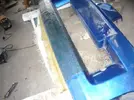
Items Needed for the Repair:
- Acetone for cleaning the tools
- Rubber gloves
- Disk roller for pushing out enclosed air
- Polyester and hardener
- Glassfiber - I used 120gr keper and 240gr uniform
- Carnauba wax
- Release gel
- Gelcoat
Making a Mould
For a good repair, you first need to make moulds, which you use to reproduce the damaged areas. Here's the first trick: You start thinking about repair if the damage has already been done, so you can't really take a mold of a damaged area. In that case, you need a second one, which I had, with a damaged corner. You can also get one from another car, because you don't damage or ruin the bumper you take the mold from.
In order to make a mould, you need to be able to take it off after the applied polyester with glassfiber has cured. Therefore, you need to wax the original at least 6 times. Be sure to wax a much larger area than you need for the mould. After you've done that, you need to run out the edges so the polyester doesn't run around the edge and lock the mold, making it impossible to get off in one piece. I use some styling foamboard for this, but any cardboard will do. Just fix it with tape.
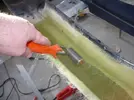
Then you need to add some release gel. I applied it with a sponge for a good smooth finish. This will be the outside result of the finished repair, so the smoother it is, the less filler and sanding you'll need in the end. I hate sanding, so I make sure it is smooth! Let it dry for about 4 hours.
Then you can start. Prepare some pieces of glassfiber and mix the chemicals. Apply the polyester with cheap brushes and dap the glassfiber until it gets transparent.

For a bit of strength, you need to apply at least three layers of fiber and polyester. Use the special disk roller to roll away trapped air bubbles. This is very important because trapped air, when cured, becomes a hole that needs to be filled afterward, or in the worst case, it makes the mould unusable.

(The picture was taken later in the process)
After the mould has cured, you can peel it off, thanks to the layers of wax and release agent.
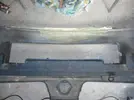
Cut off the sharp edges, and you’ve got a perfect mould that you can use several times.
Preparing the Damaged Area for Repair
The next step is preparing the damaged part. Cut out the damaged area, including small cracks, since it is broken fiber, and sand off the backside where you will place the repair. Also, chamfer the edges so you don't have a big step.
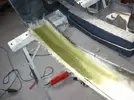
Now you need to wax the mould 6 times and add release gel to it. Then place it on the damaged area.
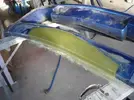
Apply a small film of gelcoat. This isn't essential, but it gives a smoother surface. You can get it in transparent or colorized. Let this cure for about 8 hours to 24 hours depending on the temperature.
Again, prepare the same mixture as for the mould and apply it to the damaged area.
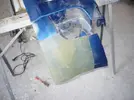
After it has cured, remove the mould and admire the result in silence.
Finishing
You will need to sand it smooth since, due to capillary effects, you will have some gelcoat between the mould and the bumper. This could be avoided if you add a bit more release gel and place the mould when the gel is still wet.
After that, send it off to the paint shop for finishing the piece.
Finally, here are two pictures of the corner area I made from the other bumper I had lying around.
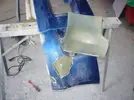

Last edited:

